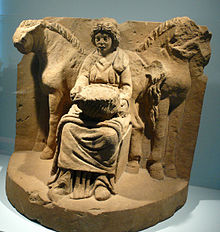Celtic god
| Celtic deities | |
|---|---|
| Member of the Tuatha Dé Danann | |

Epona, the Celtic goddess of horses and riding, lacked a direct Roman equivalent, and is therefore one of the most persistent distinctly Celtic deities. This image comes from Germany, about 200 AD.
|
The gods and goddesses of the pre-Christian Celtic peoples are known from a variety of sources, including ancient places of worship, statues, engravings, cult objects and place or personal names. The ancient Celts appear to have had a pantheon of deities comparable to others in Indo-European religion, each linked to aspects of life and the natural world. By a process of synthesism, after the Roman conquest of Celtic areas, these became associated with their Roman equivalent, and their worship continued until Christianization. Ancient Celtic art produced few images of deities, and these are hard to identify, lacking inscriptions, but in the post-conquest period many more images were made, some with inscriptions naming the deity. Most of the specific information we have therefore comes from Latin writers and the archaeology of the post-conquest period. More tentatively, links can be made between ancient Celtic deities and figures in early medieval Irish and Welsh literature, although all this was produced well after Christianization.
The locus classicus for the Celtic gods of Gaul is the passage in Julius Caesar's Commentarii de Bello Gallico (The Gallic War, 52–51 BC) in which he names six of them, together with their functions. He says that Mercury was the most honoured of all the gods and many images of him were to be found. Mercury was regarded as the inventor of all the arts, the patron of travellers and of merchants, and the most powerful god in matters of commerce and gain. After him, the Gauls honoured Apollo, who drove away diseases, Mars, who controlled war, Jupiter, who ruled the heavens, and Minerva, who promoted handicrafts. He adds that the Gauls regarded Dis Pater as their ancestor.
...
Wikipedia
